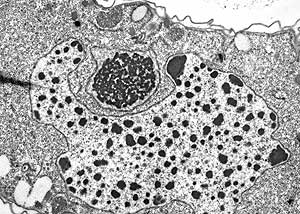The ciliated protozoan Tetrahymena thermophila is a microbial model organism for a wide variety of research disciplines. In addition to its proven importance as a model system for discovering fundamental principles of eukaryotic biology, it is the most experimentally amenable member of the Alveolates (e.g., disease-causing Plasmodium) and of the evolutionarily diverse ciliate species that colonize worldwide niches as free-living organisms, parasites (e.g., Ichthyophthirius multifiliis, or white spot, which kills aquacultured fish), and mutualistic symbionts (e.g., the cellulase-producing ciliates of the cow rumen).

Electron micrograph of T. thermophila showing both the micronucleus and (partly surrounding it) the macronucleus. Image courtesy Yifan Liu, Univ. of Michigan
Although other single-celled eukaryotes have simplified their genome content, ciliates retain an animal-like genetic complexity. Ciliates are uniquely adapted to support their large genome and cell size, yet retain rapid growth by the differentiation of two types of nuclei. This project involves sequencing the full gene content of the germline diploid micronucleus (MIC). The macronucleus (MAC) has already been sequenced. This MIC genome sequencing project will provide the first complete sequencing of a ciliate genome, providing data that is crucial for understanding ciliate diversification at a genetic rather than phenotypic level. In addition, it will allow improved construction and stability of cell lines for over-expression of eukaryotic proteins, including cellulase enzymes (to overcome the limiting hurdle of biomass-to-biofuel production) and metal-chelating proteins (to enhance the already superior capacity of ciliates for bioremediation of toxic heavy metals in industrial effluents. The project will also inform the analysis of strain-specific differences among T. thermophila cultures in features such as stress tolerance, which are important in developing ciliates for ecotoxicology applications. Finally, it will be a boon for research in the interactive, expanding model organism community.
Principal Investigator: Kathleen Collins ( Univ. of California, Berkeley)